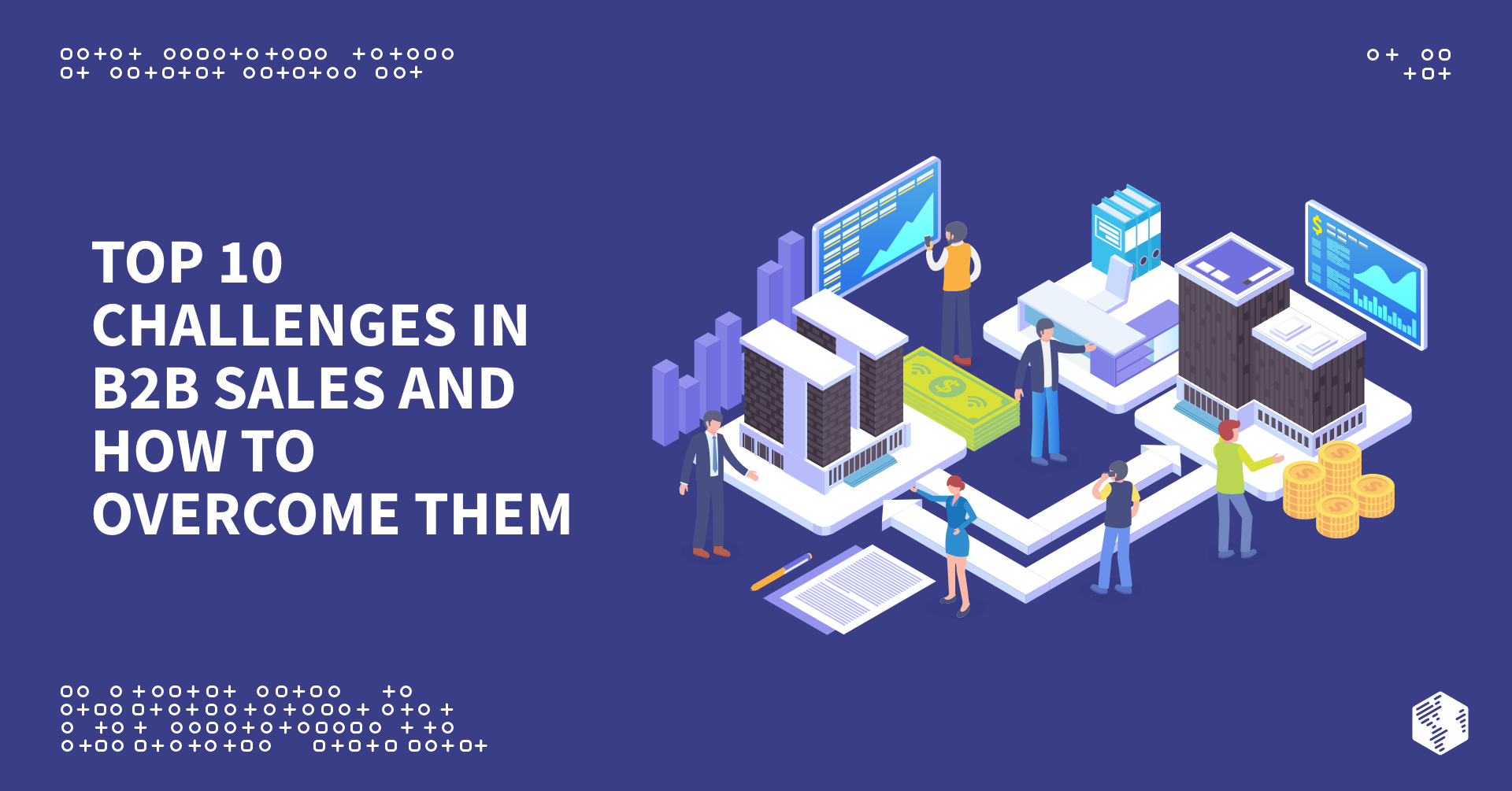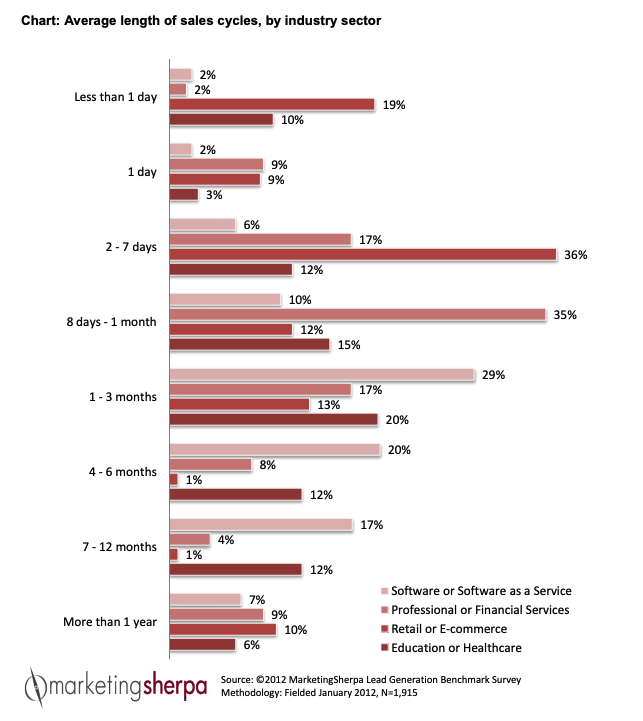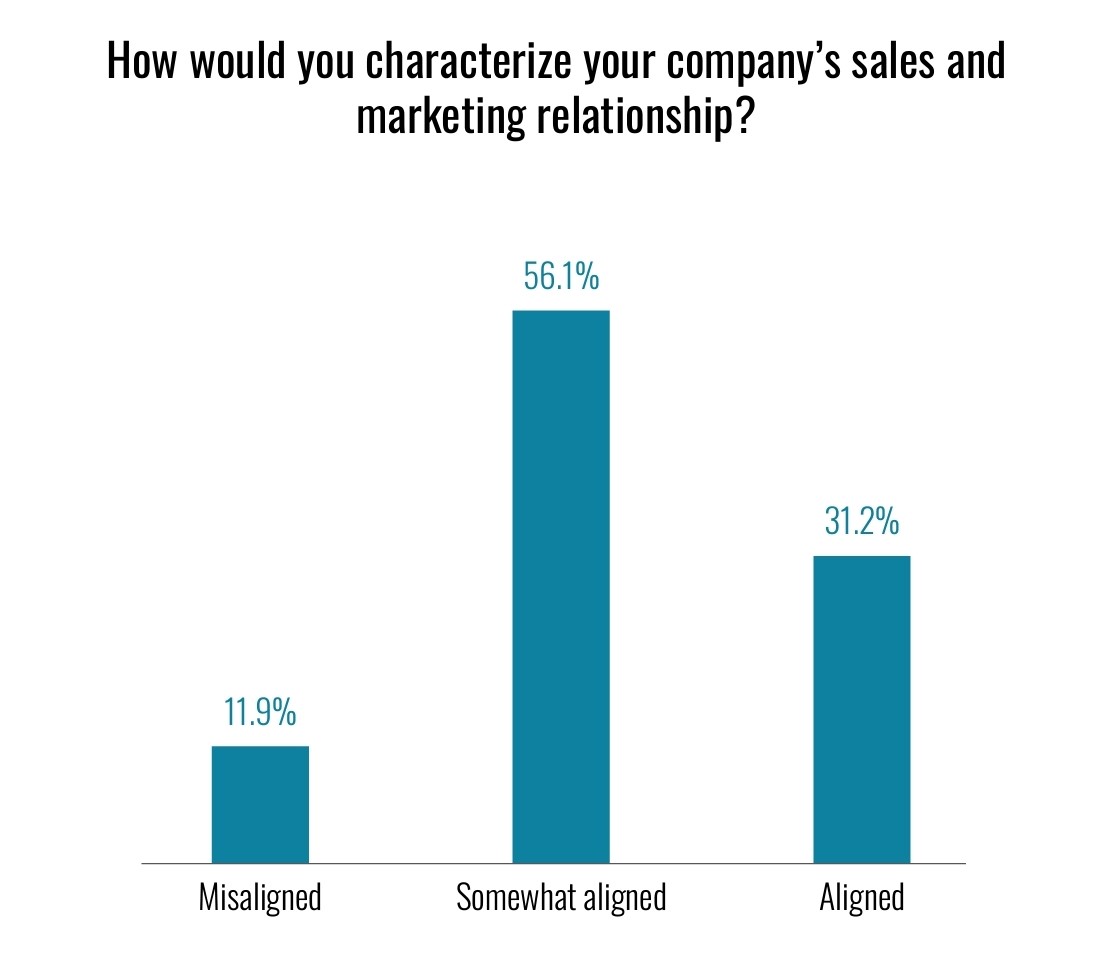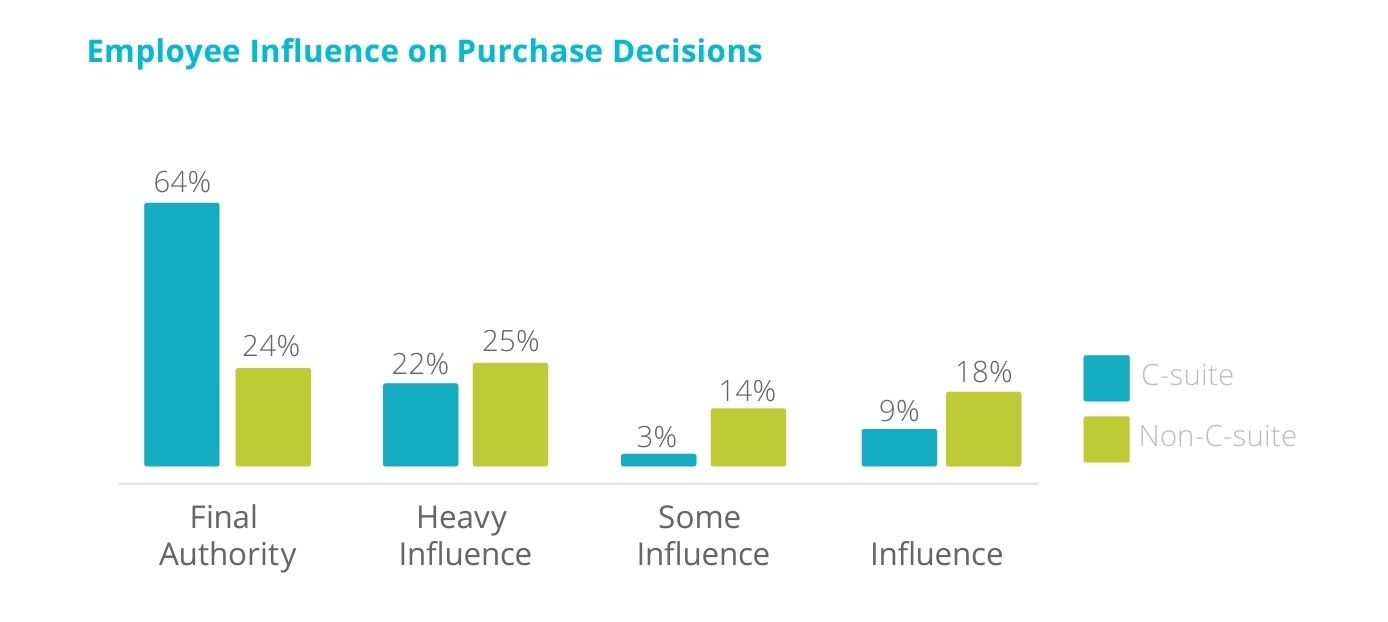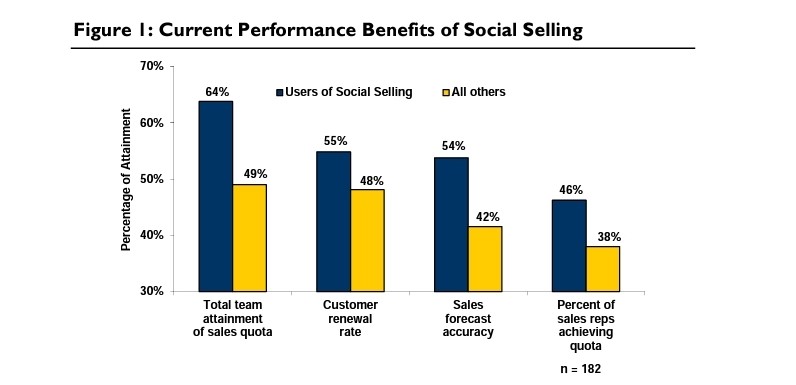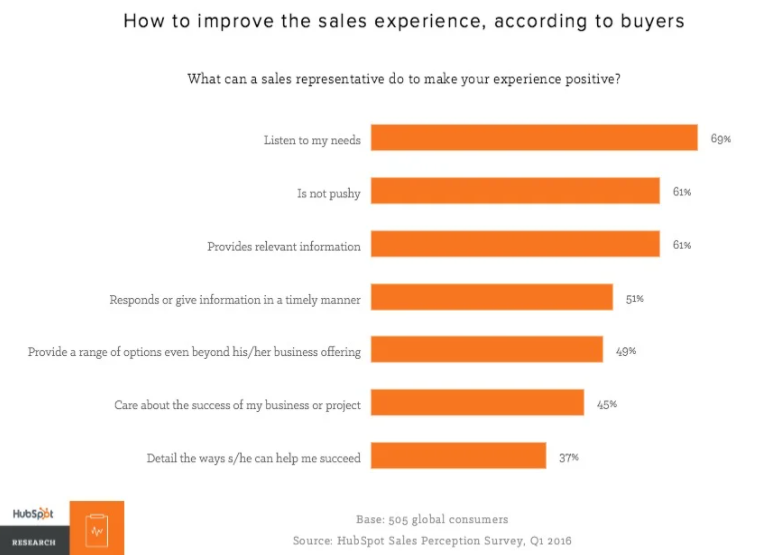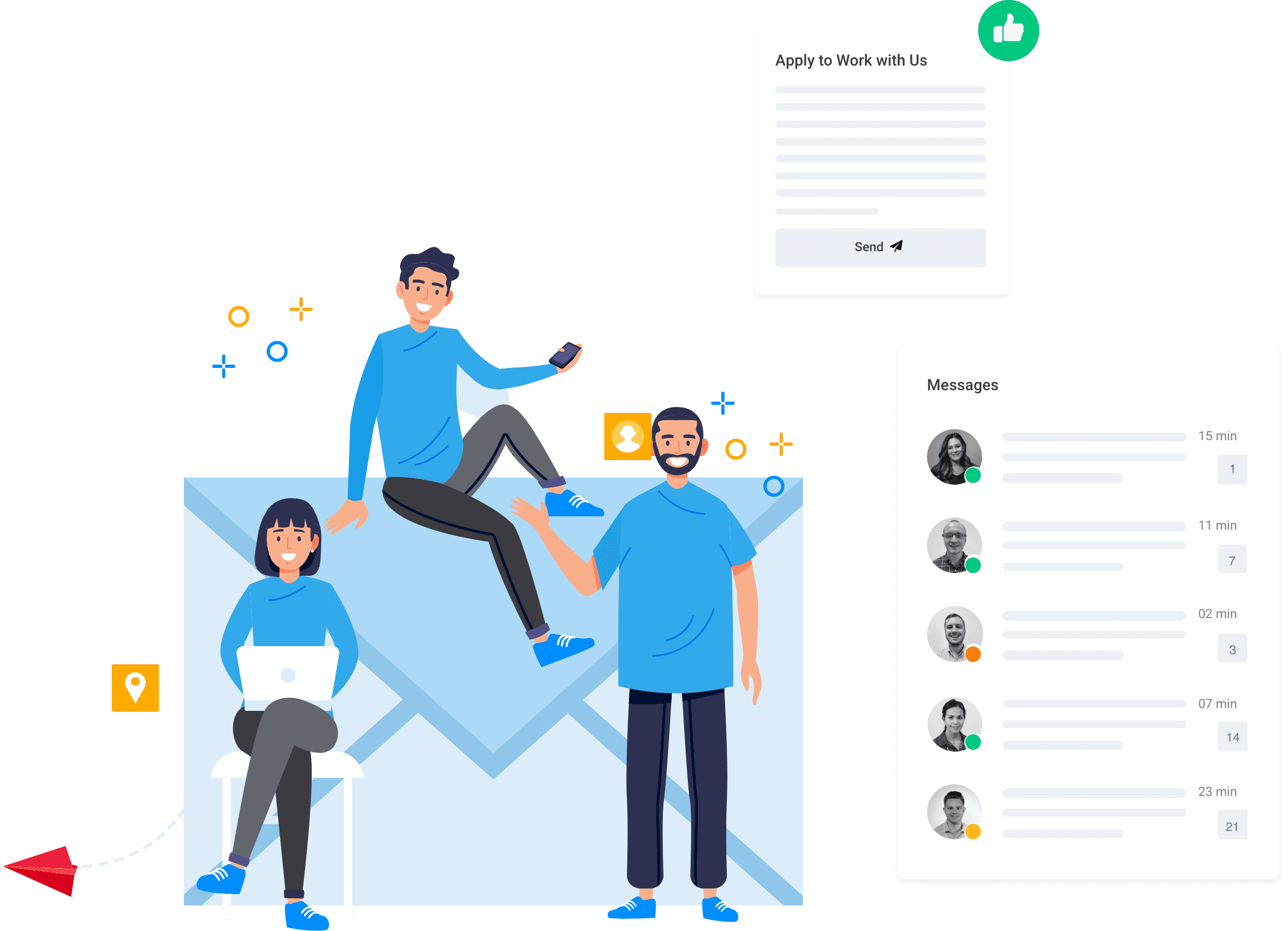Every business-to-business (B2B) company wants to acquire more customers and boost revenue. That means sales reps are under a lot of pressure to deliver results—even when faced with the unavoidable challenges that go hand in hand with B2B sales.
You face many challenges while trying to convert B2B leads into customers. Some of these challenges in B2B sales are not even of your own making Share on XRegardless, if you want to increase your conversion rates, you have to overcome these issues.
In this guide, I’ll show you 10 of the top challenges in B2B sales and how you can solve them.
Challenge #1. Long sales cycle
A long sales cycle is one of the most common challenges in B2B sales. Considering the cost of B2B products and their potential impact, it takes a long time for buyers to sign on the dotted line. You have to send emails, make phone calls, and even meet offline. Yet, as the months go by, it can look like you’re making little or no progress.
Of course, the B2B sales cycle varies across industries. Here’s the result of a study by Marketing Sherpa:
Notice a trend: Across industries, the average B2B sales cycle can take days, weeks, or even months. For instance, 73% of buyers take at least a month before buying software products.
Furthermore, the length of the sales cycle also depends on the cost of the product. On average, how long does it take from your initial contact to converting a lead? How can you shorten this cycle?
Possible solutions
- Document your sales cycle: First, you need to know the length of your sales cycle. There are variations in the way businesses measure this. Some measure from the visitor’s first website visit. However, others measure from the time they have a lead until the lead becomes a customer. Then, after calculating your sales cycle, compare it with your competitors. Are you doing better or worse?
- Identify bottlenecks in your sales process: There is no perfect sales process. Therefore, you need to analyze and identify its weaknesses. Are you getting the right leads? How long does it take to set up meetings with your prospects? Identifying these issues will help you craft a strategy to eliminate them.
- Generate sales-qualified leads: If you generate leads who don’t need your products, you’ll waste time with no results to show for your efforts. In light of this, you need to ensure the marketing department qualifies leads before sending them over.
- Provide valuable content to help buyers decide: To nurture leads effectively, you need relevant content. You can use content to capture already existing demand or to create demand for a product. These include emails, social media posts, blog posts, and more. Also, use social proof content such as testimonials, case studies, and user-generated content to show the results your prospects can achieve.
- Find ways to move sales along without being pushy: Sometimes, you need to take deliberate steps to get the prospects to take action—but the last thing you want to do is be pushy. One way to encourage action without being pushy is to provide insights into their business and how your product can improve their results. Likewise, it’s vital to show your expertise during every interaction with the prospect.
Challenge #2. Poor collaboration between marketing and sales departments
Even though sales and marketing departments look like Siamese twins in theory, it doesn’t always translate to reality. However, to generate more leads and acquire more customers, both departments need to collaborate throughout the sales funnel.
Even though sales and marketing departments look like Siamese twins in theory, it doesn’t always translate to reality. Share on XAlso, prospects need to interact with both marketing and sales reps before converting to customers. Therefore, it’s surprising that only 31.2% of companies have their sales and marketing departments aligned, according to a study by Marketo.
In the same study, 39.4% of companies with aligned teams achieved over 20% year-over-year (YOY) revenue growth compared to only 10.8% of misaligned teams. When there’s poor collaboration between marketing and sales departments, information silos exist. As a result of this inefficiency, sales reps don’t have the information they need about prospects to convert them.
On the other hand, strong collaboration between marketing and sales leads to great results. For example, SuperOffice achieved a 34% increase in revenue when they aligned sales and marketing in one of their offices.
Possible solutions
- Define essential lead contact information: What information does the sales department need to convert a B2B lead? They should inform the marketing department about the information they need.
- Develop processes that aid collaboration between sales and marketing: Since sales and marketing need to interact to close prospects, they need a defined process. How does marketing transfer leads to sales? How does sales acquire information about a prospect?
- Use CRM software: With customer relationship management (CRM) software, it’s easy for both marketing and sales departments to get a contact’s information and track their progress in the sales funnel.
- Adopt a revenue operations (RevOps) strategy: One of the essential elements of RevOps is aligning customer-facing teams like sales, marketing, and customer success so they all work toward the same growth goals, collaborate to develop optimized processes, and have access to accurate, up-to-date customer data.
CHECK THIS OUT: HubSpot vs Marketo: Which is Best for Your B2B Marketing?
Challenge #3. Generating sales qualified leads
While it’s marketing’s job to generate and qualify leads, sales reps rarely get quality leads to work with. Since most marketers are judged on the number of leads they generate, they may sacrifice quality for quantity.
According to a MarketingSherpa study, 61% of B2B marketers send all leads to sales. And of those leads, only 27% are qualified.
According to a MarketingSherpa study, 61% of B2B marketers send all leads to sales. And of those leads, only 27% are qualified. Share on XIf this situation occurs, you get too many unqualified leads—and it is almost impossible to convert them all into customers. Unfortunately, you may be seen as incompetent rather than having bad leads to work with.
To improve lead-to-customer conversion rates, the sales team needs sales qualified leads (SQLs). These are leads that have taken actions showing they want to buy your product.
Possible solutions
- Create a buyer persona: Long before you capture leads, you need to define your ideal customer. A buyer persona is a document that contains details about your ideal customer, such as name, income, job, age, pain points, and more. Having a buyer persona helps to refine marketing messages that attract only these types of people.
- Define lead scoring criteria: Even if your messages are targeted at a specific group of people, not all of them want your product right now. So, even if they submit their personal information, they won’t take actions that show buying intent. How do you score your leads? You need to define actions that a potential customer will take. This could be visiting some pages, viewing specification pages, accepting a meeting request, and more. Another way to define lead scoring criteria is to consider the buying journey of your current customers.
RELATED: 3 Steps to Developing a Smart Lead Scoring Strategy
- Use lead scoring software: Some sales CRM or marketing automation tools can help score leads and alert marketers of SQLs. First, these tools can work with your input. Then, they can also use your sales history to score leads based on how likely they are to make a purchase.
Challenge #4. Measuring ROI
When we talk about challenges in B2B sales, measuring your return on investment (ROI) is another bottleneck. For salespeople, the primary result that businesses expect is healthy returns on your department budget.
But how do you measure the impact of your activities on sales? Is it the meeting you had with them? Or the product demo? Or that they’ve decided to purchase your product before marketers even sent them over?
It can be difficult to attribute specific activities to sales. However, you need to track as many activities as possible as well as how they affect your sales metrics.
Possible solutions
- Ensure you track activities that directly link to sales: It’s critical to note activities that directly link to sales. For instance, if a buyer decides to buy after a sales call, you can record the last touch. (Note that this is not foolproof since other factors contribute to their conversion.)
- Take feedback from customers: Most times, customers know what convinced them to buy your product. To find out, all you have to do is ask them. This way, you can easily track the ROI of some of your campaigns. Beyond that, this information can help you improve your future campaigns and know which tasks and campaigns to focus on.
RELATED: Analyze the ROI of your marketing efforts with these 11 smart strategies
Challenge #5. Too much sales data
Today, the amount of data available to sales reps has boomed. Having too much sales data is one of the most common challenges in B2B sales.
For example, you can track how leads interact with your brand across many channels, such as the website pages they view, how long they spend on those pages, your social media posts they interact with, and much more. With this amount of information, you can have analysis paralysis. In this case, it becomes difficult to use data to make informed decisions.
Apart from data on prospects’ behavior, there’s also data for your results. What metrics are important for sales? With so much data, you need to streamline data so that you can focus on only the important metrics or lead behavior.
Possible solutions
- Define your key performance indicators (KPIs): What are your essential sales goals, and what metrics can help you track them? You also need to know why you’re promoting a product to a potential customer. Is the product being sold to increase market share or revenue? Once you define your sales KPIs, it’s easier to focus on the metrics that matter. Consequently, you’ll ignore vanity metrics that have little impact on your results.
- Use only the sales tools you need: One of the main factors driving the boom in data is the tools that supply different customer and sales data. To keep up with the trend, sales teams often subscribe to so many tools to have a “complete” view of their prospects. Unfortunately, these tools end up providing unnecessary data and most sales reps fail to exploit them. It’s vital to use tools that provide the data you need.
- Organize sales data with RevOps: A revenue operations approach to sales data means customer data is consistent, accurate, organized, and centralized, making it easier for sales reps to access the data they need (and ignore the numbers they don’t), leading to opportunities for more informed decision-making.
Challenge #6. Decision by committee or group of people
Since B2B products require a high amount of investment, purchasing decisions are often made by a committee or group of stakeholders. The problem is that the individuals responsible for decision-making consider different factors when buying a product.
For instance, the department that will use your product wants an excellent and easy-to-use product. On the other hand, executives may look at their budget and value the price more.
At the same time, both the user and the executive who will approve the sale influence the buying decision. For instance, Google Research revealed that 64% of C-suite employees and 24% of non-C-suite employees have the final authority on B2B purchase decisions.
This is a significant challenge for sales reps. After all, these two people belong to the same account you’re trying to convert. How do you ensure you can convince all possible decision-makers, even though they may have different needs?
Possible solutions
- Identify decision-makers and their needs: For most B2B purchases, you have more than one decision-maker. Depending on the size of the buyer’s business, you could even have two or more people involved in the decision. For instance, you can have the user, procurement officer, and the executive that will sign off the contract. For each account, you have to find the decision-makers. What piece of information do they need? What are their pain points, and how can you address them?
- Target decision-makers through account-based selling: With account-based marketing and selling, you can customize your messages based on the information each buyer needs. Furthermore, you can mention use cases that are relevant to the industry a prospect belongs to. While interacting with individuals associated with an account, you can provide the right information for each person.
Challenge #7. Increased competition
Whether your competitors are in the US or Germany, prospects can check their product offerings and interact with them. They can easily access competitor websites, check product specifications, and even set up a video call with your competitors’ sales reps.
In the past, you only had to compete with competitors in your country. Now, you have competitors worldwide. Share on XThis global B2B market can make your work more challenging as leads already know what your competitors are offering. In fact, some leads will ask you about features absent in your product that your competitors offer.
How can you gain an edge over the competition?
Possible solutions
- Segment your audience according to their interests: For the same product, potential customers need different features and are looking to solve different problems. Based on your interactions, you can detect what features are valuable to each prospect and the problem they want to solve. Thus, it’s easy to segment them according to these interests. Consequently, you can show each prospect how your product will eliminate their pain points.
- Understand and promote your unique selling proposition: What feature does your product possess that is lacking in your competitors’ offering? In some cases, your unique selling proposition may not be an entirely new feature, but it can still be an essential feature that your product executes better than your competitors.
- Perform competitive analysis: No matter how great your sales team is, there are still lessons you can learn from competitors. You need to study your high-performing competitors. How do they approach sales? What can you learn from their sales page copy? By analyzing them, you can acquire information to improve your own sales process.
YOU MIGHT ALSO LIKE: How to Increase Demand and Capture an Audience on Your Website
Challenge #8. Social sales
With billions of social media users online, you’ll find your B2B leads there, too. Business-to-consumer (B2C) companies have already exploited social selling, but since most B2B salespeople rarely use social media to sell, this is an underutilized platform.
Therefore, using social selling can help achieve your sales goals. According to research by Aberdeen Group, 64% of sales teams that use social selling achieve their sales quota. On the other hand, only 49% of those that don’t use social selling achieve their sales quota.
However, if B2B social selling is absent in your strategy, how can you start exploiting it for better results?
Possible solutions
- Choose the right social media channels: If you publish content on a social media platform that your leads rarely visit, you’ll have poor results. Therefore, it’s vital to know popular platforms for your leads and reach them there. Two popular platforms for B2B leads are LinkedIn and Twitter. By using these social media channels, you can connect with prospects and likely uncover more leads.
- Provide value on social media: Social selling goes beyond just selling. Whether on your social media page or in groups, you need to provide information that leads will find helpful and valuable—while avoiding irritating your audience.
- Create a formula for publishing content: Creating a single type of content is boring. That’s why you need a formula for creating different types of posts. For instance, one approach is to post 60% educational content, 20% curated content, and 20% promotional content. You can use any approach that suits your needs.
- Join social media groups: On social media, especially LinkedIn, you have the opportunity to join groups that make it easy for you to connect with potential customers. However, you have to join the types of groups that your prospects are likely to join. Then, publish educational posts and comments in those groups.
- Use social media scheduling tools: Without consistency, it’s difficult to gain traction on social media. A social media scheduling tool will help you schedule posts days or weeks ahead, so you don’t need to be on social media all the time. Apart from that, it allows you to interact with your audience and track your performance through analytics.
- Use social listening to track important terms: Every day, your prospects publish posts related to your brand, industry, or competitors. By using social listening tools, you can track important keywords and learn more about their pain points.
Challenge #9. Delayed decision making
Delayed decision-making is another major challenge in B2B sales. If you’re spending thousands of dollars on a product, you need to be sure—especially if the product can make a big difference to your bottom line.
Of course, there are other reasons buyers delay their product decision-making apart from price. One reason is their current needs. For example, a small business may find a CRM such as HubSpot more suited to their needs than Salesforce. Therefore, they can be reluctant to pay for a product like Salesforce.
Another reason is a low conviction about the product. If they’ve heard your sales pitch and still feel unconvinced, they’ll delay making a purchase decision. They may wait until a time when your product has improved or move on to buying from a competitor.
Whatever the reason for delayed decision-making, it’s a challenge for you as it means no sale right now.
Possible solutions
- Reiterate product benefits: When prospects are unsure of how your tool will contribute to their bottom line, you can go over benefits that their business will derive. Moreover, you can present case studies and average ROI that customers obtain as a result of using your product.
- Offer to provide more information: In some situations, prospects have an insufficient amount of information to make their decision. For example, they may need more information about features, benefits, pricing, use cases, and more. When a B2B prospect is delaying their decision, you can offer to provide more information on aspects of your tool.
- Understand why they’re reluctant: Sometimes, delaying a decision may be a gentle way of telling you “no.” After all, you’ve toiled so much on the sale, and the prospect may want to go easy on you. However, when there are reasons for reluctance, it’s vital to understand those reasons. Understanding their reasons can provide information to convince them or even improve your product offering. According to a HubSpot study, buyers rate listening to their needs as the number one way to improve their sales experience.
Challenge #10. Customer retention
Even after acquiring a customer, your work as a salesperson is not finished.
Even after acquiring a customer, your work is not done as a salesperson. Share on XCompanies often use B2B products for years. For instance, if it’s a software product, they may be on a monthly or annual subscription. If you convert a customer and they churn shortly after, it will negatively impact your customer lifetime value (CLV or LTV). Therefore, you need to follow up with a prospect to ensure they’re getting all the benefits you promised.
This is an important way to retain and turn them into loyal customers. However, it’s easier said than done. Considering the amount of work to convert a prospect, you may find it tiring to reach out after conversion, but retaining that customer for the long-term significantly increases your ROI.
Possible solutions
- Create a follow-up schedule: The reality is that it’s easy to forget to follow up once a prospect has converted into a customer. But with a follow-up schedule, you’ll get alerts for when it’s time to follow up with a customer. If you use a project management tool, you can create tasks at specific dates to reach out to customers. During these interactions, you want to learn about their experiences using your product. What issues do they have with your product? Are they solving the problems they intended to solve?
- Communicate with account managers: Since account managers are likely to have more information about customers, talk with them. How often do customers use your product? For software products, you can track customer usage. This is a strong indicator of retention. If customers use your product frequently, they have a few reasons to churn.
- Collaborate with customer success to ensure customers have a positive experience after their purchase: With a revenue operations strategy in place, sales, marketing, and customer success all work together to streamline and optimize the customer lifecycle. Collaborate with the customer success team to ensure the needs of your customers are met after the sale and to address any issues that come up.
Overcome B2B Sales Challenges with SalesOps at OneIMS
Many of the B2B sales challenges we’ve outlined here are unavoidable, so don’t be discouraged if you encounter them. The key is to find ways to overcome these challenges in B2B sales as you come across them and to do what you can to prevent them when possible.
Obviously, this is not a definitive list, and there are more challenges than we can include in this article. But you can start by creating a plan to address these 10 common B2B sales challenges.
The result? Achieving sales goals and increasing revenue.
Then, when you’re ready to optimize your sales process even further and maximize the performance of your sales team, consider adopting a sales operations (SalesOps) approach that focuses on growth.
At OneIMS, our team of SalesOps experts is ready to help your organization adopt a revenue operations framework to optimize sales operations, streamline the customer lifecycle, function more efficiently, and become better aligned with marketing and customer success teams.
We have a long history of working with companies in a variety of industries to develop innovative and data-driven marketing solutions, and we pride ourselves on producing measurable and sustainable results. But you don’t have to take our word for it. View testimonials from our clients and read our blog to get an idea of our training, experience, and track record of success.
Are you ready to overcome common sales challenges and create a sales operations framework that supports your revenue and growth goals? Schedule a consultation with us today to get started.


